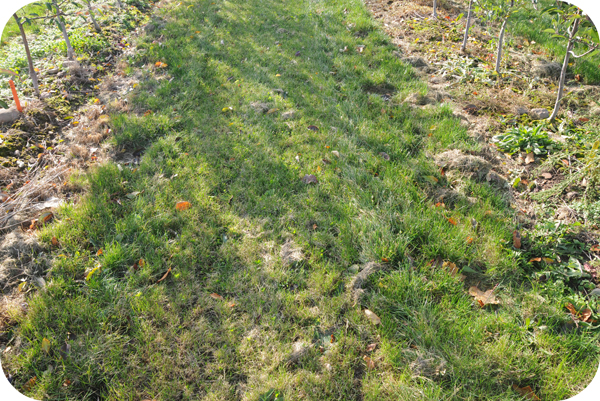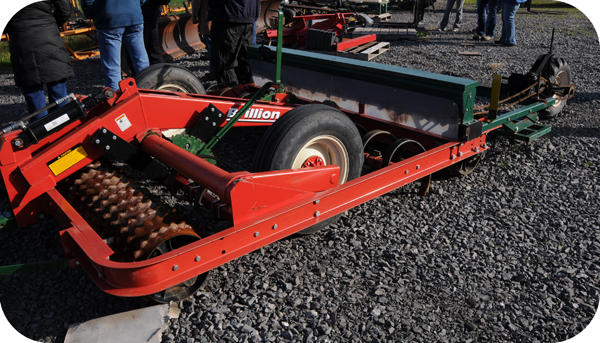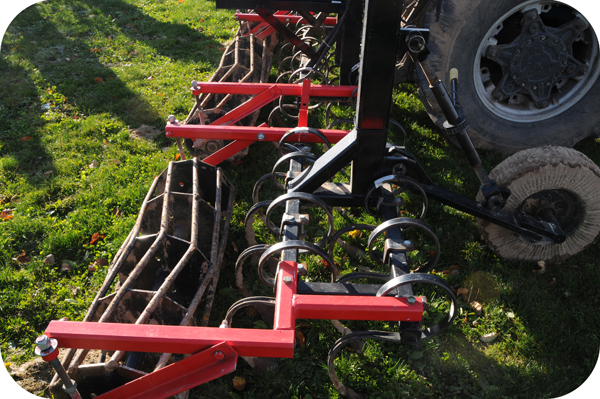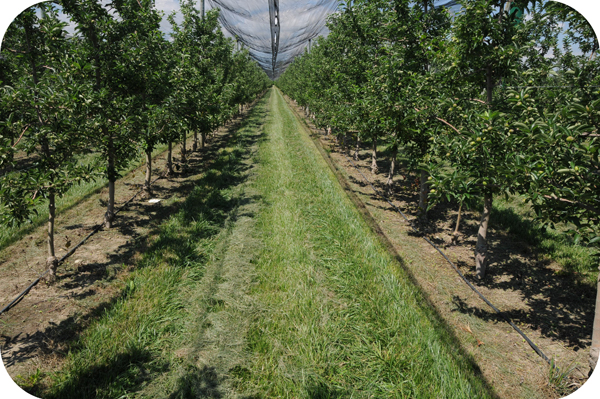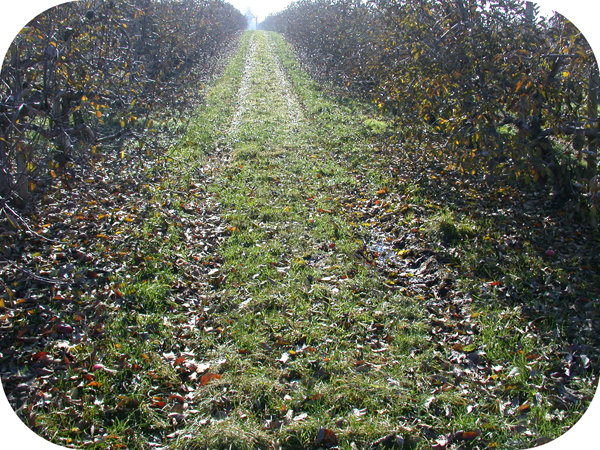Orchard Floor Management
The best orchard floor system will provide a level, solid working area for labour and equipment, in all types of weather including rain, wind and heat. It will minimize problems with weeds, pests, nematodes and dust, and will protect and maintain the soil and soil structure as a fertile resource for growing large crops of fruit.
Most orchard floors combine a grassy sod in the row middles (or alleyways) and a weed-free strip under the trees. This system is a compromise between three factors:
- What's best for tree growth and early cropping (no competition from vegetation)
- What's best for the soil (protection from erosion and compaction)
- What's best for orchard operations (stable areas for moving equipment and labour efficiency).
When to plant:
Establishing a strong grass cover in an orchard is challenging. The best time to plant grass seed is early fall, or very early spring. But in very early spring, growers are busy planting trees, building trellises, and many other spring jobs. And by early fall, tractors may have driven through the rows many times, causing compaction and rutting, and making seedbed preparation difficult. Some years, grass can be successfully seeded in early June, if these requirements can be met: a proper seedbed, cooler temperatures, and good soil moisture (or the ability to irrigate with sprinklers). Otherwise it is best to wait until cooler and wetter conditions return near Labour Day.
What to plant:
A mixture of species is recommended to help deal with the diverse extremes of the orchard environment. Usually only grass species are used to minimize problems that sometimes occur with broadleaf species (eg. Late nitrogen release with legumes, hosting insects like Tarnished plant bug). In contrast, organic growers may find some benefit from mixing nitrogen-fixing species like clover. Perennial ryegrass (PRG) will germinate quickly, but eventually dies out over time in orchards. PRG may be too dominant if mixed at more than 20%. Creeping red fescue (CRF) will spread over time, suppresses nematodes and is tolerant of drought. However, CRF is not tolerant of high temperatures sometimes experienced in orchards. Tall fescue (TF) tolerates orchard equipment well, but tends to establish in clumps. Note that turf-type tall fescues have been developed for use in sports fields, and reduce the need for mowing in orchards. Kentucky bluegrass (KBG) is an attractive grass in lawn mixtures, but requires fertilizer and irrigation that are usually not available in orchards. There are many mixtures available, but 40% CRF + 40% TF (turf-type) + 20% PRG has performed well in orchards.
How much to plant:
To minimize costs, while maximizing establishment, a rate of 20-25 lb/acre has been successful. Note that landscapers often apply up to 200 lb/ac of grass seed, but their goal is for instant thick turf.
How to fertilize:
Prior to planting take a soil test and apply the recommended fertilizer for grass establishment. Here are the recommended rates for phosphorus and potassium for sod establishment in low use turf:
| Soil Phosphorus (ppm P) | Phosphate (P2O5) required - kg/ha |
Soil Potassium (ppm K) | Potash (K2O) required-kg/ha |
|---|---|---|---|
0-3 |
90 HR* |
0-15 |
90 HR* |
4-5 |
80 HR |
16-30 |
80 HR |
6-7 |
70 HR |
31-45 |
70 HR |
8-9 |
60 HR |
46-60 |
50 HR |
10-12 |
40 MR |
61-80 |
30 MR |
13-15 |
30 MR |
81-100 |
20 MR |
16-20 |
20 MR |
101-120 |
20 MR |
21-25 |
0 LR |
121-150 |
0 LR |
26-30 |
0 LR |
151-180 |
0 RR |
31-40 |
0 RR |
181-210 |
0 RR |
41-50 |
0 RR |
211-250 |
0 RR |
51-60 |
0 RR |
250+ |
0 NR* |
61-80 |
0 NR* |
||
80+ |
0 NR* |
||
| (0.5 M sodium bicarbonate extract) mg P L-1 of soil | (1 M ammonium acetate extract) mg K L-1 of soil | ||
*Expected response: HR - high, LR - low, RR - rare, NR - none
Apply 20 kg N/ha before planting to encourage moderate sod growth and establishment.
How to plant:
Planting with a turf seeder eg. Brillion will evenly distribute the tiny seeds, and press them into the soil well to obtain the needed soil-seed contact. If this equipment is not available, a pasture seeder with grass attachment will work. Or using a hand-operated spreader (known as a fiddle) can work well with a skilled operator. The key is to spread the seed in calm winds, harrow and pack lightly and time seeding for just before a gentle shower.
Early care:
Depending on the species in your mix, seedlings will appear in 1-3 weeks after a good rain. Wait as long as possible before driving on new seedlings, but start mowing to prevent weed escapes from choking out the grass and/or going to seed. Ensure mowers blades are sharp to reduce damage to young grass plants. If possible, apply overhead irrigation during dry conditions to help establish the grass.
Weed-free strip:
It is critical to prevent weeds from growing under the trees, especially in the first 3 months after planting (known as the Critical Weed-free Period). Usually the final tillage after the trees are planted will level the ground around the tree and remove early weeds. The weed-free strip should be wider than the drip line of the tree (new orchards should have a 3 to 4 foot wide strip). If you are planning to use a mulch (which will suppress weeds as well as preserve soil moisture), apply it before the next weeds emerge. There are several herbicides registered for newly planted trees (see p. 305, Publication 75, Guide to Weed Control. Note that rates are often lower for new trees to avoid tree damage. Combining a grass herbicide with a broadleaf herbicide will give broader spectrum control eg. Dual II Magnum + Princep. Be sure to match your soil organic matter level to your choice of herbicides to avoid hurting the trees. Avoid using glyphosate products in the first few years, as they might be absorbed and damage trees or allow diseases to infect them. Herbicide sprays should be directed to the ground from each side of the row, avoiding the trunk and any root suckers.
For more information: Soil Management For Orchards And Vineyards, OMAF and MRA Factsheet Order No. 92-120.



